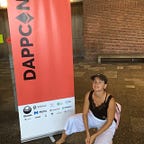Taraxa: bringing trust to the machine world.
Steven’s vision
It all started back in 2013 when Taraxa’s future founder heard about Bitcoin from Bobby Lee at a Stanford alumni meetup. Fascinated by the promise of the underlying technology that enables decentralized governance, Steven started to dig deeper. He soon realized that decentralization indeed holds a lot of promise for organizing interaction between economic units — both humans and machines — in a much more efficient way than it is done today.
Our next milestone stems from Steven’s insight (one that, in fact, made him quit his day job in strategy consulting): current centralized governance models have hit their scaling limitations in the face of rapidly increasing and changing complexity. Increasingly sophisticated technology and the rise of workforce mobility require ever-more coordination to successfully complete economic projects, which leads to an unmanageable amount of intra- and inter-organizational complexity. Centralized governance leverages a multi-layered managerial system that was highly efficient a few decades ago — when the world was less complex and things didn’t change so quickly — are especially ill-suited for today’s reality.
Ultimately, the system that was designed to manage complexity has become far too complex and inefficient itself getting to the point where it destroys more value than it creates.
Take for instance a case of a typical warehouse that’s part of a supply chain network. In it, each buyer/partner would demand the warehouse to run a client of their own operational software and hardware systems. Imagine walking into the warehouse and seeing 100 laptops and 100 scanning systems, each corresponding to a single client or partner (by the way, this isn’t imagination, this is happening right now). Now imagine if that warehouse now scales to 1,000 customers? A centralized governance demands the world around it to conform to its systems and standards so everything can be centrally managed, something that has become not only operationally untenable, but works to stifle innovation and slows the pace of decision-making on a daily basis, further reducing such a system’s ability to effectively cope with rapid technological and social changes.
As we see, centralized governance over economic units has worked out very well up to a point, but today it doesn’t work so well anymore and will only get worse.
But how could these units operate without relying on a centralized authority? Remove it, and there is no way to be convinced that other players in the ecosystem will keep their promises (or even exist at all). As we see, eventually, it all comes down to trust, and the centralized governance model is just one of many trust-enforcing mechanisms that our civilization has produced in the past few millennia.
Okay, so how do you coordinate when economic interactions become too complex? How about introducing decentralization to distribute the load among the participants.
Throwing in a novel operational mechanism sounds like a logical step, and the decentralized way powered by the booming blockchain technology appears to be a good option that perfectly fits the ongoing socio-economic shift. The phenomenon of decentralization is at its core penetrating the society at every level — from communication technologies to economic patterns — and building the new decentralized economy bit by bit.
Okay, now let’s translate this to the world of IoT. Machines are no different from humans in the sense that they also need to adhere to a certain playbook that evokes trust in their work. But there’s no such playbook yet, because to evoke trust every connected device first needs to become an independent unit with a set of determinants, such as identity, asset ownership, and an ability to make economic decisions. Hence, for the ever-growing number of autonomous devices to scale and be secure, we need a decentralized system. Since there’s no such system or mechanism yet, the market out there is huge — and that’s the major driver for Taraxa’s mission.
Just like with the corporate and social decentralization of governance to handle complex human interactions, the next logical step would be to apply this model to handle interactions between IoT devices.
We are not chasing a ‘killer dApp’
Here’s how Taraxa is paving the way for decentrally-run independent IoT units of the future.
Taraxa is built to help businesses trust device-generated data during business operations, transactions and partnerships. The reason we started building a Layer one protocol is very simple: while building a ‘killer dApp’, we want to possess the technical expertise to understand, design, implement and adapt the underlying infrastructural technology. Without this know-how, we are then in a position to better understand the implications and use cases that can be built on top of it. Unlike many, we are not delusional about the status-quo: instead of talking about things that will be possible twenty years from now, we are very hands-on and down to earth. We’ve been in talks with the enterprise to understand where decentralized governance can be applied to add value to their business today. Most of our clients are currently in Japan, with applications in asset leasing, second-hand vehicle trading, and smart parking.
In the long run, Taraxa’s infrastructure is meant to lay the groundwork to enable all IoT devices to be blockchain-compatible straight out of the factory. We will start from the silicon level to infuse trust in connected devices enabling them to naturally communicate with one another, each with their own unique identities, able to own and trade assets.
Watch this space to see track our progress and check out Taraxa’s Github to discover our tech stack.
- website: taraxa.io
- blog: medium.com/taraxa-project
- discord: discord.gg/WaXnwUb
- reddit: www.reddit.com/r/Taraxa_Project/
- telegram: t.me/taraxa_project
- twitter: twitter.com/taraxa_project
